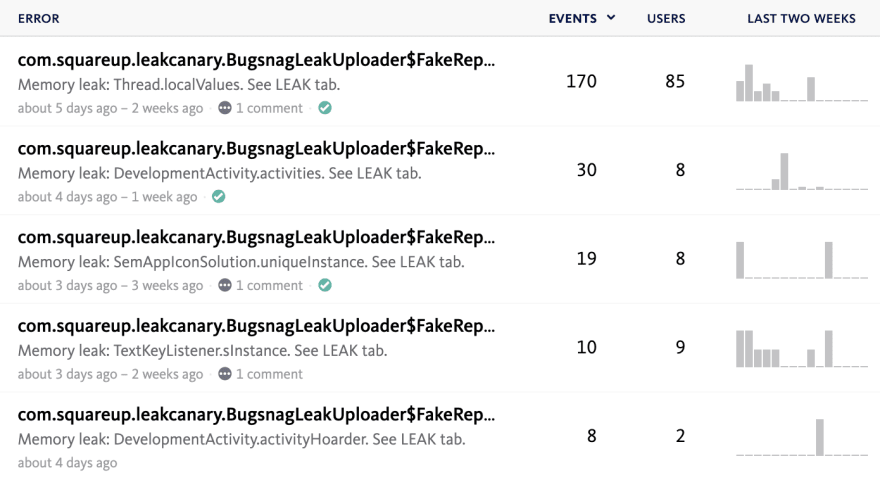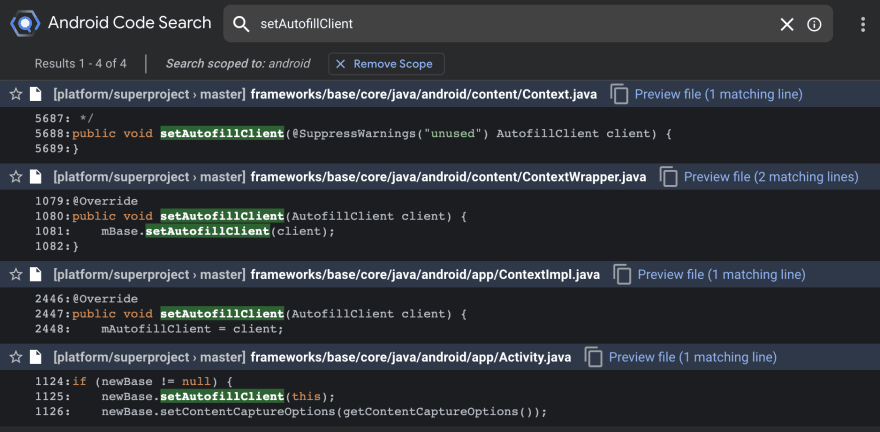Beware PackageManager leaks!

Py ⚔
Posted on June 29, 2020
While I was investigating an Android memory leak, I took these notes as I learnt about the lifecycle of android.app.ContextImpl and android.app.ApplicationPackageManager. I started poking at cs.android.com and somehow ended up decompiling the Android 11 framework bytecode 😅. If you don't know what ContextImpl is, read on!
Take away: if you need to keep a PackagerManager instance, get it from the application Context.
// Don't do this:
HelperThing.packageManager = activity.packageManager
// Do this instead:
HelperThing.packageManager = activity.applicationContext.packageManager
A Wild Leak Appears!
At Square, I configured our debug builds to upload leak traces to Bugsnag. That way, we can find which leaks happen the most and investigate them.
I started looking into a leak that didn't have anything to do with our app's code:
┬───
│ GC Root: System class
│
├─ android.app.ApplicationPackageManager class
│ Leaking: NO (a class is never leaking)
│ ↓ static ApplicationPackageManager.mHasSystemFeatureCache
│ ~~~~~~~~~~~~~~~~~~~~~~
├─ android.app.ApplicationPackageManager$1 instance
│ Leaking: UNKNOWN
│ Anonymous subclass of android.app.PropertyInvalidatedCache
│ ↓ ApplicationPackageManager$1.mCache
│ ~~~~~~
├─ android.app.PropertyInvalidatedCache$1 instance
│ Leaking: UNKNOWN
│ Anonymous subclass of java.util.LinkedHashMap
│ ↓ PropertyInvalidatedCache$1.tail
│ ~~~~
├─ java.util.LinkedHashMap$LinkedHashMapEntry instance
│ Leaking: UNKNOWN
│ ↓ LinkedHashMap$LinkedHashMapEntry.key
│ ~~~
├─ android.app.ApplicationPackageManager$HasSystemFeatureQuery instance
│ Leaking: UNKNOWN
│ ↓ ApplicationPackageManager$HasSystemFeatureQuery.this$0
│ ~~~~~~
├─ android.app.ApplicationPackageManager instance
│ Leaking: UNKNOWN
│ ↓ ApplicationPackageManager.mContext
│ ~~~~~~~~
├─ android.app.ContextImpl instance
│ Leaking: UNKNOWN
│ ↓ ContextImpl.mAutofillClient
│ ~~~~~~~~~~~~~~~
╰→ com.example.MainActivity instance
Leaking: YES (ObjectWatcher was watching this because
com.example.MainActivity received Activity#onDestroy() callback and
Activity#mDestroyed is true)
The name ApplicationPackageManager seem to imply this package manager is an application scoped object, ie a singleton. Therefore it's not leaking, and the leak is probably somewhere after ApplicationPackageManager instance.
...
├─ android.app.ApplicationPackageManager instance
│ Leaking: UNKNOWN
│ ↓ ApplicationPackageManager.mContext
│ ~~~~~~~~
├─ android.app.ContextImpl instance
│ Leaking: UNKNOWN
│ ↓ ContextImpl.mAutofillClient
│ ~~~~~~~~~~~~~~~
╰→ com.example.MainActivity instance
Leaking: YES
ContextImpl.mAutofillClient seems fairly suspicious, let's look into it!
A primer on Context & ContextWrapper
On Android, Context (source) is a god object that provides access to app resources. Major Android components (Application, Activity, Service) extend Context. More specifically, they extend ContextWrapper (source), a subclass of Context that delegates to a base context.
The Application class hierarchy looks like this:
/**
* Interface to global information about an application environment.
*/
abstract class Context
abstract fun getFilesDir(): File
// More methods to access app resources...
}
/**
* Proxying implementation of Context that simply delegates all of its calls to
* another Context.
*/
open class ContextWrapper : Context {
private var mBase: Context? = null
protected fun attachBaseContext(base: Context) {
mBase = base
}
override fun getFilesDir() = mBase.getFilesDir()
}
/**
* Base class for maintaining global application state.
*/
open class Application : ContextWrapper() {
fun onCreate() = Unit
}
Where is the actual implementation of Context.getFilesDir()? In ContextImpl!
/**
* Common implementation of Context API, which provides the base
* context object for Activity and other application components.
*/
class ContextImpl : Context {
override fun getFilesDir(): File {
synchronized(mSync) {
if (mFilesDir == null) {
mFilesDir = File(dataDir, "files")
}
return ensurePrivateDirExists(mFilesDir)
}
}
}
Back to ContextImpl.mAutofillClient
Activity overrides attachBaseContext() to set the autofill client of its base context to itself (source):
open class Activity : ContextThemeWrapper() {
override fun attachBaseContext(newBase: Context) {
super.attachBaseContext(newBase)
if (newBase != null) {
newBase.autofillClient = this
}
}
}
Since the base context of an activity is ContextImpl, this part of the leak trace now makes sense:
...
├─ android.app.ContextImpl instance
│ Leaking: UNKNOWN
│ ↓ ContextImpl.mAutofillClient
│ ~~~~~~~~~~~~~~~
╰→ com.example.MainActivity instance
When is mAutofillClient set back to null? Never (source).
So, is that what's causing this leak? Should the activity clear the autofill client on its base context when it gets destroyed?
Before jumping to conclusions, we need to understand the lifecycle of ContextImpl. Is it an application scoped singleton? Is it activity scoped? Something else?
The lifecycle of ContextImpl
It turns out, every Android component that is a Context has a ContextImpl set as its base context. ContextImpl.outerContext points back to the Android component it serves.
This teaches us that the lifecycle of ContextImpl is tied to the lifecycle of its outer context.
We can now update the leak trace:
...
├─ android.app.ApplicationPackageManager instance
│ Leaking: UNKNOWN
│ ↓ ApplicationPackageManager.mContext
│ ~~~~~~~~
├─ android.app.ContextImpl instance
│ Leaking: YES (ContextImpl.mOuterContext is an instance of
| com.example.MainActivity with Activity.mDestroyed true)
│ ↓ ContextImpl.mAutofillClient
│ ~~~~~~~~~~~~~~~
╰→ com.example.MainActivity instance
Leaking: YES (ObjectWatcher was watching this because
com.example.MainActivity received Activity#onDestroy() callback and
Activity#mDestroyed is true)
What about ApplicationPackageManager then?
Is ApplicationPackageManager application scoped?
ApplicationPackagerManager instances are created in ContextImpl.getPackageManager() (source):
class ContextImpl : Context {
override fun getPackageManager(): PackageManager {
if (mPackageManager != null) {
return mPackageManager
}
IPackageManager pm = ActivityThread.getPackageManager()
mPackageManager = ApplicationPackageManager(this, pm)
return mPackageManager
}
}
This teaches us that the lifecycle of ApplicationPackagerManager is tied to the lifecycle of the ContextImpl that created it, which is tied to the lifecycle of its outer context.
My early assumption that ApplicationPackagerManager is an app wide singleton was incorrect!
Take away: if you need to keep a PackagerManager instance, get it from the application Context.
// Don't do this:
HelperThing.packageManager = activity.packageManager
// Do this instead:
HelperThing.packageManager = activity.applicationContext.packageManager
I updated LeakCanary to take this new information into consideration. We can update the leak trace once again:
┬───
│ GC Root: System class
│
├─ android.app.ApplicationPackageManager class
│ Leaking: NO (a class is never leaking)
│ ↓ static ApplicationPackageManager.mHasSystemFeatureCache
│ ~~~~~~~~~~~~~~~~~~~~~~
├─ android.app.ApplicationPackageManager$1 instance
│ Leaking: UNKNOWN
│ Anonymous subclass of android.app.PropertyInvalidatedCache
│ ↓ ApplicationPackageManager$1.mCache
│ ~~~~~~
├─ android.app.PropertyInvalidatedCache$1 instance
│ Leaking: UNKNOWN
│ Anonymous subclass of java.util.LinkedHashMap
│ ↓ PropertyInvalidatedCache$1.tail
│ ~~~~
├─ java.util.LinkedHashMap$LinkedHashMapEntry instance
│ Leaking: UNKNOWN
│ ↓ LinkedHashMap$LinkedHashMapEntry.key
│ ~~~
├─ android.app.ApplicationPackageManager$HasSystemFeatureQuery instance
│ Leaking: UNKNOWN
│ ↓ ApplicationPackageManager$HasSystemFeatureQuery.this$0
│ ~~~~~~
├─ android.app.ApplicationPackageManager instance
│ Leaking: YES (ApplicationContextManager.mContext.mOuterContext is an
| instance of com.example.MainActivity with
| Activity.mDestroyed true)
│ ↓ ApplicationPackageManager.mContext
│ ~~~~~~~~
├─ android.app.ContextImpl instance
│ Leaking: YES (ContextImpl.mOuterContext is an instance of
| com.example.MainActivity with Activity.mDestroyed true)
│ ↓ ContextImpl.mAutofillClient
│ ~~~~~~~~~~~~~~~
╰→ com.example.MainActivity instance
Leaking: YES (ObjectWatcher was watching this because
com.example.MainActivity received Activity#onDestroy() callback and
Activity#mDestroyed is true)
🤔
Let's zoom in on the beginning of the leak trace:
┬───
│ GC Root: System class
│
├─ android.app.ApplicationPackageManager class
│ Leaking: NO (a class is never leaking)
│ ↓ static ApplicationPackageManager.mHasSystemFeatureCache
│ ~~~~~~~~~~~~~~~~~~~~~~
├─ android.app.ApplicationPackageManager$1 instance
...
Something's weird: ApplicationPackageManager has a static field named mHasSystemFeatureCache, which is an LRU cache. According to the AOSP field naming conventions:
- Non-public, non-static field names start with
m. - Static field names start with
s.
We can also see that ApplicationPackageManager.HasSystemFeatureQuery is an inner non static class which holds on to its outer class, the ApplicationPackageManager instance (via this$0), but it's also a key in the ApplicationPackageManager.mHasSystemFeatureCache static LRU cache.
...
├─ android.app.ApplicationPackageManager$HasSystemFeatureQuery instance
│ Leaking: UNKNOWN
│ ↓ ApplicationPackageManager$HasSystemFeatureQuery.this$0
│ ~~~~~~
...
All of this looks suspicious, we should take a closer look, but we cannot find ApplicationPackageManager.mHasSystemFeatureCache in the Android sources.
At Square, we've had this leak on a Pixel 3 XL (Android 11 DP 2). On StackOverflow someone reported it on a Pixel 4 XL (Android 11 DP 2), there's also a bug report on the emulator (Android 11 DP) and another on the Pixel 4 XL (Android 11 DP 2).
So, this looks like an Android 11 leak in developer previews. Unfortunately, the sources aren't available yet. Or are they?
Decompiling framework.jar on Android 11
Lucky for us, Google provides us with Android 11 emulator images. We can start an emulator and pull the Android framework bytecode:
adb pull /system/framework/framework.jar
framework.jar contains dex files:
META-INF
android
classes.dex
classes2.dex
classes3.dex
classes4.dex
res
We can decompile those dex files with dex2jar. classes2.dex contains the ApplicationPackageManager class:
public class ApplicationPackageManager extends PackageManager {
private static final PropertyInvalidatedCache<HasSystemFeatureQuery, Boolean>
mHasSystemFeatureCache = new PropertyInvalidatedCache<HasSystemFeatureQuery,
Boolean>(256, "cache_key.has_system_feature") {
protected Boolean recompute(HasSystemFeatureQuery var1) { ... }
};
private static final class HasSystemFeatureQuery {
public final String name;
public final int version;
public HasSystemFeatureQuery(String var1, int var2) { ... }
public boolean equals(Object var1) { ... }
public int hashCode() { ... }
public String toString() { ... }
}
}
We found the ApplicationPackageManager.mHasSystemFeatureCache static field and the ApplicationPackageManager.HasSystemFeatureQuery inner static class. In the leak trace, ApplicationPackageManager.HasSystemFeatureQuery was an inner non static class, but now we can see it's a static class so it looks like this leak was fixed in the latest Android 11 release.
Conclusion
Edit: we have the sources now! The leak was introduced here and fixed here, a month later. Unfortunately Android 11 DP 2 was already cut.
Wow, that was quite a ride. I had no idea this blog would be so long when I started investigating. I hope your learnt as much as I did and that you enjoyed it. Let me know on Twitter!

Posted on June 29, 2020
Join Our Newsletter. No Spam, Only the good stuff.
Sign up to receive the latest update from our blog.




